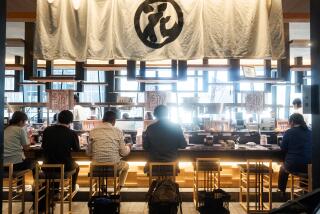Doing Business : Ferraris, Sing-Alongs, Sexy Ads Help Tokyo Language Schools Sell ABCs : English lessons were never so fun as entrepreneurs vie for billions in profits.
TOKYO — Welcome aboard the most conspicuous English-language classroom in Tokyo. It’s parked in front of busy Shinjuku station, a Gargantuan double-decker bus painted in screaming yellow. Inside, it’s outfitted with pink velour seats, a flip-down karaoke screen and glass chandeliers.
Eight Japanese and the Australian teacher are in the back, introducing themselves as the bus takes off promptly at 1 p.m. for Asakusa Temple across town. Yasu, a thirtyish police officer who moonlights as an aerobics instructor, is explaining to the class why he has decided to study English.
“Because,” he announces with a cheerful grin, “I want to arrest foreigners.”
The $375,000 “English Classroom on Wheels,” as the bold black letters tout it, is the brainchild of Kosei Yoshimura and other directors of the Lexington Institute of Foreign Languages.
The school bought the bus on special order two years ago as its entry into what is fast becoming a theater of the bizarre in ways to learn English.
Japan’s $22.6-billion English-language market has sparked frenzied competition. In Tokyo alone, the number of schools has skyrocketed to 3,000--twice the number five years ago. How to break out of the pack? With gimmicks galore.
“There isn’t another English classroom like this in all of Tokyo,” Yoshimura says, with the proud look of a new father.
Maybe not, but Tokyo isn’t called the most competitive marketplace in the world for nothing. Students here not only can learn English on wheels. They also can do it on a yacht. Or while crooning karaoke. Or during ski trips, mountain climbing, going to the movies. Or while cooking, acting, even studying the Bible.
The trend is dubbed “ nagara Eikaiwa ,” or “English conversation while . . .” doing something else. Grammar drills in a dreary classroom don’t quite cut it these days with the young office workers who regard English classes as a trendy hobby or a way to find foreign romance as much as preparation for international business or graduate study abroad.
“You gotta have an extra edge,” says Kent Gilbert, who licensed his name and image to the U.G. Corp. of Tokyo to begin an English school a few years ago.
Gilbert is Japan’s most famous gaijin tarento , or foreign talent, a former Mormon missionary fluent in Japanese who endlessly pops up on television talk shows and quiz games, makes speeches and pitches products.
“Everyone in Japan always decides to do everything at the same time,” Gilbert says. “So about five years ago, all these schools started springing up. By the time we entered three years ago, the number of schools had already doubled.”
Amid the ferocious competition, Gilbert’s board chairman, Takahiko Ueda, wasn’t about to be caught napping. He also chose a rolling classroom--a Rolls-Royce. A white-gloved chauffeur drives a teacher and students around Tokyo as they make English conversation. There are bonus stops at an elegant tearoom and the new Tokyo City Hall.
If the Rolls doesn’t suit a student’s fancy, there’s an antique London taxi purchased from Japanese millionaire Rocky Aoki or a Ferrari Testarossa--”the only pearl white Ferrari in Japan,” boasts Joe Prang, administrative coordinator of what is officially called Kent Gilbert’s Foreign Language Institute. Last year, U.G. Corp. bought a yacht; English lessons at sea are beginning next month.
“I feel like a movie star,” trills Hiroe Omae, a 22-year-old homemaker, during her eighth lesson aboard the Rolls with Prang.
It helps that Prang, 28, occasionally is mistaken for actor Charlie Sheen by the Japanese pedestrians who gawk and peer as the limo rolls along the crowded streets.
The Model Language Studio, meanwhile, offers English lessons while performing plays such as “The Odd Couple.” The school touts the idea of “learning English with your body.”
Lexington, in addition to the temple tour aboard the Classroom On Wheels, also offers English-language karaoke lessons, with “My Way,” “Love Me Tender” and “I Left My Heart in San Francisco,” the invariable favorites.
Its main Shinjuku office is equipped with a “cinema salon” for watching foreign movies and a “conversation bar” furnished like a coffeehouse for chitchat in English.
But the granddaddy of all English-language schemes may be a budding project called “Bi-Lingual Land.”
The idea is to build a kind of English never-never land, complete with hotel, theme park, artificial lake and all foreign staff members. Japanese visitors must speak English once they step inside the park, giving them the illusion of visiting a foreign country without leaving Japan, said Bi-Lingual spokeswoman Aki Fisher.
Fisher said land has been acquired in Nagano prefecture, but no firm schedule for building the park has been set.
English language school officials insist that the various schemes are more than advertising gimmicks. Outside the confines of a traditional classroom, students supposedly can relax and let the English naturally flow out of them.
The typical Japanese high school graduate has studied English six years; the university student probably knows more arcane grammar rules than a native speaker. Yet Japanese officials lament that few actually know how to use the language.
Omae, for instance, says she is still nursing a psychological scar from the time a salesclerk in Hawaii laughed at her attempts to speak English. Since then, she clammed up. “Now I can only relax at school,” she says.
Eye-catching advertisements are another way schools are competing for clients--mostly office workers or homemakers in their 20s and 30s who often take out loans to finance courses that average $4,000 a year.
The latest advertisement from Bi-Lingual, for instance, portrays a woman stripping off her T-shirt, her naked back and curve of breast exposed, with the caption, “Japan’s New Era.” The advertisement is meant to convey the necessity of English in Japan’s new age of internationalization, spokeswoman Fisher explained.
Another school’s posters portray a cartoon of a very buxom blonde in a tight dress asking for directions, while a chagrined and sweating Japanese businessman is thinking, “I can’t speak English!”
The Kent Gilbert school’s new offering shows a young Japanese woman daydreaming, “Shall I call Tony tonight?”
Asked what, exactly, the school was trying to sell, board chairman Ueda explained the advertisement was meant to convey that students can learn how to use telephone English.
“Oh, yeah, everybody is after sex appeal,” Gilbert says.
Press reports here have charged that well-toned bodies are plucked out of health clubs and deployed as English teachers.
But school officials insist they are running language classes, not afternoon social clubs, and the Kent Gilbert school, for one, has strict rules against hanky-panky between teachers and students.
Competition for English language student dollars has attracted some of Japan’s biggest corporate names. Yamaha, Japan Air Lines, Daimaru department store, Sony Corp., Suntory and Sumitomo all currently operate English schools.
Competition among English teachers has intensified as well.
An influx of Australians, New Zealanders and Canadians seeking jobs on “working holiday” visas has flooded the market for English teachers.
Employers now have the luxury of paying teachers less and requiring college degrees, although knowledgeable sources say many prospective teachers easily purchase phony degrees from Thailand or Hong Kong and that few schools bother to confirm credentials.
Indeed, substandard teachers was the second most frequent complaint against foreign-language institutes lodged with the Kokumin Seikatsu Center in Tokyo, a public consumer hot line. (Failure to refund money was the most frequent.) In a reflection of the English school boom, complaints also rose to 1,092 in 1990 compared to 318 in 1986.
But for students such as Omae, the mad market scramble mainly means cheaper prices and more selection--and a chance to ride buses and boats, sing songs and go skiing, while struggling to master the mysteries of a foreign language and culture.
Back aboard the Classroom on Wheels, the students are loosening up, just as promoters predicted they would.
Yuko is divulging a recent divorce.
Midori is confessing that her marriage is boring.
Akiko, a scuba diver, is telling the group she has really white skin. “Please believe me,” she says, with a titter.
“Just get ‘em to have fun,” booms Steve, the Australian teacher. “If you get ‘em to have fun, they’re learning English and they don’t even know it.”
Grammar, Gimmicks for Sale Thousands of schools vie for a piece of Japan’s $22.6-billion English-lesson market. Here are facts about the size, costs and attractions of some of the competitors:
SCHOOL STUDENTS FEE PER SESSION SALES HOOK (group/private) Aeon 46,000 $14/$84 correspondance courses, study-abroad programs Berlitz 21,000 $35/$87 112-year history, established teaching method Bi-Lingual 40,000 $24/$74 focus on studying current events in English, romantic interior design, rigorous teacher training system ECC 227,000 $19/$77 focus on practical English Gregg 5,000 $12/$68 curriculum focus on practical living situations Kent Gilbert 750 $19/$61 English lessons aboard fancy cars, drop-in classes at any branch available. Lexington 2,000 $17/$69 bus tour, cinema salon, conversation lounge WIN 20,000 $14/$43 ticket system allowing study at any branch.
SOURCES: Nikkei Trendy magazine, Times research
Megumi Shimizu, a researcher in The Times’ Tokyo bureau, contributed to this article.
More to Read
Inside the business of entertainment
The Wide Shot brings you news, analysis and insights on everything from streaming wars to production — and what it all means for the future.
You may occasionally receive promotional content from the Los Angeles Times.











